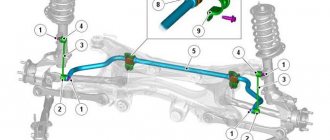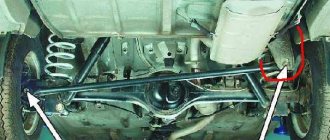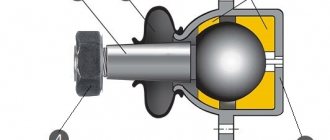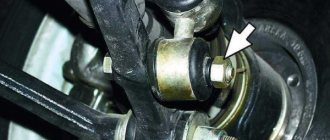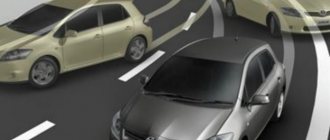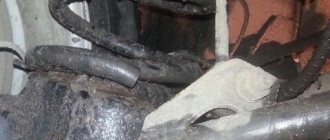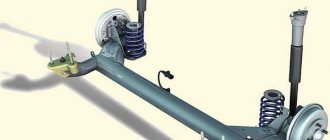The suspension of a modern car includes a large number of different components and parts. At the same time, during the operation of a vehicle, drivers most often encounter failure of suspension arms, ball joints, shock absorbers, upper shock absorber support (support bearing), silent blocks or stabilizer link (stabilizer link).
In this article we will talk in more detail about what stabilizer struts are, what they are needed for and what function they perform. We will also look at what signs indicate the need to replace a stabilizer link and how the stabilizer link is checked, as well as how to change stabilizer links, which stabilizer links are best to choose, etc.
Function of stabilizer struts and their service life
The struts act as a connecting element between the stabilizer and the suspension. They absorb the loads that arise when the car turns and thereby prevent body roll. Structurally, it is a metal rod with articulated movable joints at the ends. The hinges are covered with anthers on top.
If the stabilizer links are damaged, the car will lose control and may skid or overturn.
The service life of the struts, according to manufacturers, is about 100 thousand kilometers. But for Russia such figures are irrelevant. Even the most careful drivers feel the first signs of strut wear after traveling 50 thousand km from the moment of replacement, and if they are of poor quality, then sooner. There is no point in delaying the installation of new racks. This is dangerous both for the car’s suspension (repairing it will cost more than replacing the struts) and for the driver and passengers.
Principle of operation
Mounting method
Stabilizer struts are used to dampen forward waves that arise in different parts of the car when driving on uneven road surfaces. The stabilizer struts are secured using special lugs on the rear beam and in the front suspension. Manufacturers set the approximate service life of racks, usually it is 120,000 kilometers.
You will learn how to replace stabilizer struts with your own hands in this article. A car's suspension consists of numerous parts. It is impossible to call any details the main ones. The design of modern cars is very complex, so all the details are equally important.
Part requiring replacement
The failed part must be repaired, if possible, or replaced with a new one. Stabilizer struts play a significant role in the operation and comfortable use of the car. If problems arise, they require timely repair or replacement. Delaying the resolution of this issue may result in vehicle breakdown or an accident. Experienced car enthusiasts can easily change stabilizer struts without resorting to anyone’s help.
Believe me, every home craftsman can replace the racks. This will require an inspection hole and an overpass. Some craftsmen make do with a simple jack. The main thing is to relieve the stability stabilizer.
Signs of malfunctioning stabilizer struts
It is quite difficult not to notice the wear of the struts. Several characteristic signs will indicate this:
- knocking in the suspension when crossing small irregularities on the road;
- car roll when turning;
- when braking the car, the body begins to sway;
- When driving in a straight line, the car spontaneously goes off course.
To exclude other malfunctions with the same symptoms, you can turn the steering wheel to its extreme position and try to swing the rack with a pry bar (or even by hand). If this can be done without much difficulty, then a replacement is needed.
Check and selection
The stand is new
You will know that there is something wrong with the struts by hearing the characteristic knocking noises that the car will make when driving on uneven road surfaces and turning.
Take the choice of new stabilizer struts seriously.
You must use racks designed specifically for your car model. Stands that match yours in angle and length cannot be considered interchangeable.
DIY stabilizer link replacement
Removing old ones and installing new ones is quite possible for an ordinary car enthusiast without any special plumbing skills. They always change in pairs. It is worth noting that your car may not have rear struts (as well as the stabilizer itself). On some models, their function is performed by other suspension parts.
Replacement of the rear stabilizer struts is carried out as follows:
- the handbrake is applied, wheel chocks are placed under the wheels;
- the rear axle of the car is raised with a jack;
- if necessary, the connecting elements of the racks are treated with WD-40 spray;
- the axle shaft is held at the end by a hexagon;
- unscrew the nut securing the stand;
- the installation site is cleaned, a new rack is installed;
- the nut securing the strut is tightened;
- the car's axle is lowered;
- the fastening nuts are tightened completely.
After driving a couple of hundred kilometers, you must definitely check the fastening nut and, if necessary, tighten it.
Replacement of the front stabilizer struts is carried out by analogy. Sometimes brake hoses can get in the way and will have to be removed from the mounting brackets for a while.
Diagnostic features
Checking the strut is quite simple, just raise the front axle of the car (both wheels must be hanging, otherwise it will be impossible to determine the malfunction), carry out a visual assessment, and also tug the stabilizer bar a little. These actions are enough to determine the malfunction. If the front axle is suspended, the driver will be able to assess the condition of the ball pin (whether it is securely fixed).
Diagnostics of stabilizer struts
On a note! Manufacturers recommend using stabilizer links for a specific model. Even if all the parts match, this does not mean that it will fit a particular car.
Visual inspection of stabilizer struts
Selecting New Racks
To ensure that replacing racks does not turn into a mandatory annual ritual, you need to be able to choose them correctly. We recommend the Singapore brand IBERIS. There are several reasons for this:
- you can easily select racks for any popular car model;
- product compliance with European quality standards (ISO);
- more than reasonable price;
- Manufacturer's warranty - 12 months.
You can buy original IBERIS stands (with a hologram on the packaging) in the IXORA store, and polite managers will definitely help you make the right choice.
| Manufacturer | Detail number | Part name | Applicability* |
| IBERIS | IB112147 | Stabilizer link IBERIS Nissan | Nissan X-Trail, 2001-2013 |
| IBERIS | IB112175 | Stabilizer bar IBERIS rear Lexus | Lexus GX, 2002-2009 |
| IBERIS | IB112191 | IBERIS rear stabilizer link Mazda | Mazda 323, 1998-2005 |
| IBERIS | IB112089 | IBERIS rear stabilizer link Mitsubishi | Mitsubishi Eclipse, 1999-2005 |
| IBERIS | IB112157 | IBERIS rear stabilizer link Nissan | Nissan X-Trail, 2001-2013 |
| IBERIS | B112053 | Stabilizer link IBERIS rear left Honda | Honda Accord VII, 2004-2008 |
| IBERIS | IB112045 | Stabilizer link IBERIS rear left Honda | Honda Civic, 2005-2012 |
| IBERIS | IB112050 | Stabilizer link IBERIS rear left Honda | Honda CR-V, 2012 |
| IBERIS | IB112123 | Stabilizer link IBERIS rear left Mitsubishi | Mitsubishi Pajero, 2002 |
| IBERIS | IB112052 | Stabilizer link IBERIS rear right Honda | Honda Accord VII, 2004-2008 |
| IBERIS | IB112040 | Stabilizer link IBERIS rear right Honda | Honda CR-V, 2002-2006 |
| IBERIS | IB112048 | Stabilizer link IBERIS rear right Honda | Honda CR-V, 2012 |
| IBERIS | IB112122 | Stabilizer link IBERIS rear right Mitsubishi | Mitsubishi Pajero, 2002 |
| IBERIS | IB112049 | Front stabilizer bar IBERIS Honda | Honda Civic, 2006-2012 |
| IBERIS | IB112071 | Front stabilizer bar IBERIS Hyundai | Hyundai Grandeur, 2005-2011 |
| IBERIS | IB112068 | Front stabilizer bar IBERIS Hyundai | Hyundai Sonata, 1988-1991 |
| IBERIS | IB112097 | Front stabilizer bar IBERIS Kia | Kia Sorento, 2002-2006 |
| IBERIS | IB112174 | Front stabilizer bar IBERIS Lexus | Lexus IS200, 1999-2005 |
| IBERIS | IB112140 | Front stabilizer bar IBERIS Mazda | Mazda 323, 1998 |
| IBERIS | IB112146 | Front stabilizer bar IBERIS Nissan | Nissan Bluebird, 1991-1995 |
* Please check the applicability of parts specifically for your car with our managers by phone (calls within Russia are free).
Additional recommendations
As you can see, the procedure for replacing racks is not very complicated if everything is done correctly. Here you need to be careful and follow safety precautions. The choice of the racks themselves must also be taken with full responsibility, because there are many non-original low-quality parts on the auto parts market . Experienced craftsmen recommend buying original spare parts or high-quality analogues from well-known manufacturers.
Selection of stabilizer struts
During the replacement process, it is advisable to evaluate the condition of other suspension elements in order to promptly identify and replace worn or damaged parts. All threaded connections must be treated with a special lubricant. This will make repair work easier in the future.
How to replace front stabilizer struts
How to extend the life of stabilizer links
Stabilizer links on bushings can be reinforced with polyurethane silent blocks - there are companies that specialize in the production of suspension parts from this material. But there is no guarantee that you will be able to find a suitable size bushing, plus you will have to wait for delivery if there are no craftsmen in the city. Then you still need to repress it, and this usually requires special equipment.
With rods on hinges, everything is simpler and cheaper - you can extend their life (but they still won’t become eternal) with improvised tools and materials. The method is not complicated, but it requires some skill and patience. The point is to put more grease for the joints under the boot, since there is practically no grease there from the factory (one drop, as a rule). When the “ball” runs dry, its wear accelerates. A minimal amount of moisture or sand under the boot will quickly destroy the plastic liner and the hinges will rattle.
Factory lubrication of the stabilizer link (there is almost none - the finger is bare), photo dr1ver.ru
A generous amount of lubricant protects the working surface from moisture and reduces friction. Any viscous lubricant for joints will do; it is sold in every spare parts store. To get the grease under the boot, you need to bend it, to do this you need to remove one of the retaining rings - which of the two depends on the design and execution of the spare parts, it turned out to be easier for me to remove the large one, since the small one was in the form of an elastic band. You can take it off, but you may not be able to put it back on.
Factory lubrication of the stabilizer link, photo dr1ver.ru
When the boot is moved to the side, it is convenient to add lubricant. Try not to lubricate the boot seat and retaining ring - then it will be difficult to put them in place. We add lubricant without fanaticism - the excess will still be squeezed out when installing the boot in place, which will complicate reassembly.
Stabilizer link lubrication, photo dr1ver.ru
It should look something like the photo above. When assembling, you must not damage the rubber of the boot; with holes in the rubber, the stabilizer link will not last long, no matter how much lubricant there is.
Stabilizer link lubrication, photo dr1ver.ru
After lubricating one joint, we proceed to the next one and then assemble the rack back (this may be more difficult than disassembling). The first experience can be a little nervous, but with a little patience, everything will work out.
The stabilizer link is almost assembled, all that remains is to put the spring ring in place, photo dr1ver.ru
When everything is ready, you can install the rack on the car. After such manipulations, it definitely comes off more than usual. The main thing is not to “sour” your fingers - otherwise you will have to cut off the still “alive” one.
Installed stabilizer link for Rover 75. photo dr1ver.ru
It is not always possible to remove the boot - some manufacturers use special metal rings to secure them (joint to joint), which does not imply dismantling. Or they need to be snacked and exchanged for others that still need to be found. In this case, the game is not worth the candle.
High-level “Kulibins” are installed in the joint housings of grease nipples (grease fittings) to introduce grease and add it periodically. They say that this makes the parts last forever, but we haven't tested it (and don't believe it).
Varieties
There are many stabilizer links. They mainly differ by car make. Each car has its own type of traction.
There are varieties of materials for the manufacture of silent blocks and stabilizer link bushings. There are standard rods, and there are polyurethane stabilizer links. The standard ones are most often made of ordinary rubber, and the second ones are made of polyurethane.
Drivers claim that polyurethane is better than rubber based on the fact that it is designed to last longer. In fact, this is true. An ordinary rubber bushing and silent block last no more than 10 thousand kilometers, while silent blocks and polyurethane bushings do not even show signs of wear. Despite the fact that this material is more expensive, it is still in demand. This happens because it is better to change a part once every 15-20 thousand kilometers than to change 2 or 3 parts in the same period.
We identify all problems ourselves
It has already been said here that the most unreliable, most “fragile” part of the stabilizer is the struts. This is done on purpose so that in the event of an accident, the least damage can be caused. Let's name the main symptom accompanying the breakdown of stabilizer struts or rods. This is a dull knock that occurs when driving over any irregularities, potholes and even small stones. And sometimes the car begins to roll out of the roll worse - conclude that one of the struts has already been torn off. But knocking will be observed in 90% of cases! It can come from both the front and rear suspension.
Let's say there is a bushing in the design of the stabilizer struts (photo 2 in Chapter 2). It will then be more difficult to identify the defect: even if the bushing is destroyed, knocking does not always occur. More often the sound will be muffled, quiet, and generally difficult to hear.
Creaks and crunches, especially when cornering, usually indicate the destruction of the boot. But the defect itself, we repeat once again, is rare. The hinge shown in the photo will begin to deteriorate over time. And the creak should then turn into a grinding sound.
Ball joints inside the struts
How to choose racks
One of the main parameters of stabilizer struts is their size. It is necessary to select new rods so that the dimensions completely match. Otherwise, this may lead to unpredictable consequences during the operation of the car.
But even knowing the required size, the choice of rods remains extremely large. Original spare parts sometimes have a very high cost and are usually designed for operating conditions different from those around us (for example, if you are the owner of a European foreign car, then it is obvious that the service life promised by the manufacturer is designed for travel on smooth European roads, and not on ours domestic off-road). Therefore, people often resort to buying analogues.
When purchasing analogues, we advise you to pay attention to the country of origin. Often on parts, information about the country of packaging is larger than information about the country of manufacture. This may confuse the buyer.
The most common offers on the market are from the following reputable manufacturing companies: LEMFORDER (Germany), TOPRUN (Germany-China), STR (South Korea), Links Master (Russia).
What to do if it is impossible to purchase by article number
The solution will be to select the required part according to its size. Just unscrew it and measure well on all sides. There are specialized sites where the procedure is automated. For example, ]VTR[/anchor] invites its customers to choose a suitable solution on the official portal - https://vtr.su/shop. Go to the appropriate section and enter the necessary parameters:
By clicking on the corresponding link on the screen, you can obtain information on the selected part. For example, dimensions of AU3903S:
You can also select according to existing sizes. For example, on the site https://xn--80aafnj4alqen.xn--p1ai/?form=1&idd=21. It is enough to indicate the length and rotation angle in the appropriate fields:
This is enough to obtain information on the details. It is important to note that service life greatly depends on the quality of the material used. There are a number of other factors that influence operation. You need to carefully monitor the condition of the suspension.
Types of anti-roll bars
Stabilizers vary depending on their installation location. For the front and rear. If the installation of the latter is optional, then the front stabilizer is always installed on modern passenger cars.
There is an active stability stabilizer. Its cardinal difference from its counterparts is its flexibility. He is able to change his rigidity depending on the situation. It reacts most harshly to sharp turns, and when the car moves off-road, this part of the suspension can turn off, which is achieved by automatically adjusting its moving parts.
Types of stability stabilizers
The stiffness of the stabilizer can be changed in several ways. First of all, you can use hydraulic cylinders instead of struts or use them instead of bushings. If the stabilizer system is hydraulic, the hydraulic drive is responsible for the rigidity. These measures will help adjust the stabilizer.
Rating of stabilizer struts
Below is a list of stabilizer struts by rating:
- Lemforder (Lemforder). Country: France. Such racks are purchased from them by manufacturers General Motors, Mitsubishi, Toyota, Opel, Volkswagen, Mersedes-Benz, Audi, BMW, Ford, Volvo, Fiat and some other brands. Reputable quality and good resource.
Reviews (+) Reviews (-) Lehforbeck tested it in an Opel Omega B, Opel Vectra C, Huyndai Santa Fe New. Had no problems with them either. Lemforder is not suitable for Japanese cars. I can easily drive more than 35 thousand km. No problem. After 0.5 years of operation, the Lempherder began to knock. - Topran (Topran). Country: Germany, China. The country code will tell you where the part was made.
Positive reviews Negative reviews For the money this is a good option. I haven't found any problems with the Opel Omega B yet. They started knocking after 5 thousand km. The stand is a consumable item. Therefore it is necessary to change often. Over 50 thousand km there are no squeaks or knocks. - Sasic (Sasik). Country: France (Normandy). Renault (Renault), Peugeot (Peugeot), Citroen (Citroen) install them on their cars. The cost is not high, the quality is good.
Good feedback Bad reviews Chinese analogs lasted 10,000 km. We installed Sasik until we drove 15,000. After a short run of 5,000 km, these stabilizers sat down. Not very expensive and they last. They burst within 2 weeks. - GMB. Country: Japan. The main consumers are Japanese and Korean cars: Toyota, Nissan, Mitsubishi, Hyundai, Kia, Renault, Suzuki, GM.
Good feedback Bad reviews GMB for a mileage of 35 t.km showed no problems. No negative reviews found The old Pajero (Pajero) had no problems with stabilizers. - CTR. Country: South Korea. Among the consumers are the following car factories: Ford, Kia, Hyundai, GM, etc.
Positive reviews Negative reviews I've only recently been using it. For 2 months there are no crunches or squeaks. When there is nothing else to bet, it will do. Withstands cornering loads well. After 10 thousand kilometers they began to knock. Perhaps it was a fake. - Sidem (Sidem). Country: Belgium. Popular brand. It has 80 factories around the world.
Positive reviews Negative reviews If you can buy a Belgian-made one, there will be no problems. Nowadays you can find them made in China and they don’t last long. . - Links Master. Country: Russia (Tver). Prices are lower than their counterparts. No reviews have been left yet. If you used it, write in the comments and I’ll add it.
Whether the reviews are real online or not is unknown. But everyone should understand that how long the stabilizers and struts will last depends on the style and manner of driving.
Helpful advice: do not brake on bumps (for example, on a speed bump). You need to brake before the obstacle. This simple action can extend the service life of many parts of the car's chassis.
Worn stabilizers
The effect of worn stabilizer links is, first of all, noise around the wheels (creaks and knocks) when overcoming bumps at low speeds. Connector wear can also lead to poor driving performance. As a result, loose connectors will reduce the effectiveness of the side stabilizer, which will lead to reduced driving stability. However, because the vehicle's driving stability gradually deteriorates, it is difficult to determine on this basis when the connector needs to be replaced. It should be remembered that prolonged driving with worn stabilizer links can contribute to faster damage to other elements of the suspension system (for example, the stabilizer).
More often than not, it is the symptoms mentioned above that signal to the driver that you should contact a mechanic. By looking under the car, you can be 100% sure of this problem. However, when replacing fasteners, do not wait for signs of wear to appear, but do it regularly approximately every 15 thousand. km or every two years. The rubber parts of the connector can become damaged even if the car is not driven very often or goes over serious bumps too often.
Choosing racks for Lada Vesta
Today, purchasing new parts for a car of any brand is not a problem. When replacing the original racks, you should check the price and also remember their length. To determine the correct size, measure the distance between the centers of the ball pins.
As a rule, for cars this figure is standard - 275 mm. If you install a part of the wrong length, you can expect incorrect operation of the suspension. With a longer stand, the mechanism will wear out very quickly.
Experts warn motorists against purchasing parts from little-known brands, as their quality is questionable.
High-quality stabilizer struts are characterized by the following parameters:
- make the car stable;
- racks are immune to chemical compounds;
- have impact resistance;
- equipped with quality materials;
- increased service life due to preservation of the hinge function by the damper;
- the stand is immune to vibrations.
Knowing the article number of racks from VAZ and other manufacturers, you can select a spare part at the best price. Don't chase foreign brands.
Experienced motorists are advised to take a closer look at the following models of racks:
- STR CLMZ 19,
- FEBI 12768,
- Renault 8200 669 065,
- LEMFORDER 28334 01,
- MONROE L15600,
- SIDEM 19061 and others.
